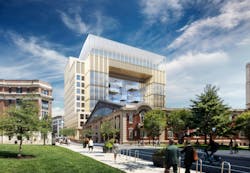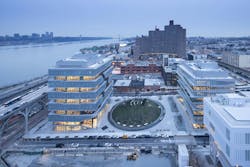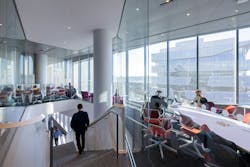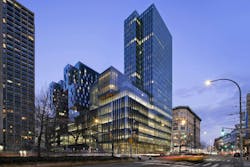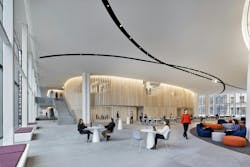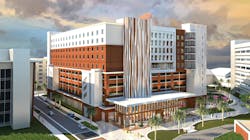Supersizing higher education: Tracking the rise of mega buildings on university campuses
In early February, on the campus of Drexel University, Gattuso Development Partners broke ground on what will be the largest life sciences building in Philadelphia when it’s completed in late 2024.
This $450 million, 11-story building, known by its address, 3201 Cuthbert Street, and designed by Robert A.M. Stern Architects (RAMSA), will encompass 519,647 sf of wet and dry labs, 11,708 sf of retail space, and underground parking with 137 slots. Drexel, which owns the land within Philadelphia’s University City research corridor, has preleased 60,000 sf in the building. Two-fifths of the building’s interior space is earmarked for academic purposes.
3201 Cuthbert Street is one of a spate of recent building projects, in various stages of development or completion on or near higher education campuses, that are 450,000 sf or larger. While no single factor drove their larger sizes, each of these projects stretches the boundaries of a broader trend toward multipurpose and/or mixed-use combinations that require more leg room.
How and by whom these projects were financed, the availability and location of land where the developments occur, and how they fit into the institution’s image, recruitment, sustainability goals, and community agenda all played roles in these buildings’ ultimate mass, say AEC firms who have worked on recent campus projects.
Several university campuses raise their bar
Mega buildings on college campuses aren’t unusual. But what has been different—or at least noteworthy—lately is the sheer number of supersized projects that have been in the works over the last 12–15 months.
In the case of 3201 Cuthbert Street, Gattuso had several motivations for initiating this project, not the least of which being Philadelphia’s emergence as a life sciences magnet for venture capital investment and new construction demand.
Gattuso “had a large potential tenant, and it knew that Drexel was looking for more lab space,” recalls Meghan McDermott, a Partner at RAMSA. (Drexel and SmartLabs have preleased 45% of this building’s labs.) McDermott adds that the land is situated between the university and a train stop. “It’s the missing piece.”
Several other large-scale buildings are reshaping the landscapes on university campuses:
- On January 18, the John A. Paulson Center opened in Greenwich Village, representing the largest single expansion in New York University’s 192-year history. Sixteen years in the making, this $1.2 billion, 735,000-sf building includes 58 classrooms, three residential towers, a 350-seat theater and orchestral rehearsal hall, and below-ground athletic facility. “It’s almost a campus within a campus,” says Richard Maimon, a Partner with Kieran Timberlake, which designed the Paulson Center with Davis Brody Bond.
- Last October, the University of Tampa in Florida broke ground for what will be the largest building on its 110-acre campus: a 460,000-sf, 10-story mixed-use building that is scheduled for completion in the fall of 2024. Designed by KWJ Architects in collaboration with the project’s executive architect Baker Barrios Architects, and built by Beck Group, the building will have 600 beds (a number that’s become “a sweet spot” for mixed-use buildings with student housing, says Grayson Silver, AIA, Managing Principal with Baker Barrios Architects), 37 faculty offices, five classrooms, a designated study lounge for veterans, and a 9,000-sf sky park.
- In Washington, D.C., Howard University, working with the developers Lowe, FLGA, and Davenport Group, plans to start construction next fall for a 10-story, 500,000-sf building on 1.85 acres adjacent to its main campus in the Capitol’s Shaw neighborhood. The building, according to the university, will have up to 500 beds, 27,000 sf of retail space, and 246 below-grade parking spaces.
- Princeton University in New Jersey recently announced its plans to build a new campus home for environmental studies and its School of Engineering and Applied Science. Ennead is the architect and Whiting Turner the CM on this project, which is scheduled for completion in the fall of 2024 and will encompass 660,000 sf over four buildings that are connected underground in one continuous sequence. The university says this project will also offer “strong connections” to nature and outdoor space. James Corner Field Operations is the landscape architect.
- James Corner Field Operations also designed the one-acre outdoor plaza between the two buildings that comprise the new home for Columbia University’s School of Business on the university’s burgeoning Manhattanville campus in New York. Designed by Diller Scofidio + Renfro (DS+R) in collaboration with FX Collaborative, the 492,000-sf facility, which opened in January 2022, is spread over the 11-story Henry R. Kravis Hall and the eight-story David Geffen Hall, named after their famous benefactors. “The buildings are siblings with the same DNA but slightly different,” observes Miles Nelligan, an Associate Principal with DS+R. Turner Construction was the CM on this project, which doubles the business school’s available space.
- The University of California at Berkeley broke ground in January 2022 on the 500,000-sf Helen Diller Anchor House, a student housing building with 772 beds specifically for transfer students. Located a block from Berkeley’s campus, this project is part of university’s response to having the lowest availability of student housing of any branch of University of California system. The university’s long-range goal is to add 8,800 new beds, doubling its existing inventory. Anchor House is one of 11 housing sites in and around its campus that Berkeley has identified for development.
Heading off development opponents
A number of these larger projects, including the Helen Diller Anchor House and Paulson Center, are characterized by their universities as “gateways” to their campuses. Maimon adds that the Paulson Center is designed to reflect NYU’s “dynamism” in ways that the campus’s older buildings do not.
Any magnum-sized construction or development project, though, will also attract attention and opponents. Kyle Gibson, Director of Communications for Capital Strategies, Berkeley’s development arm, told BD+C in an email that the university isn’t entertaining interview requests during construction of Anchor House, citing as one reason “several active litigation matters regarding our housing development projects.”
Minimizing community and municipal resistance is key to moving these projects forward. 3201 Cuthbert Street falls under “as of right” zoning, meaning that the developer agrees to comply with all applicable zoning codes. In other words, the project won’t require special permits, variances, or discretionary actions by regulatory boards, explains McDermott, whose firm helped Gattuso Development Partners with its feasibility studies for this building.
Before the ceremonial shovels hit dirt to celebrate its new building’s groundbreaking, NYU had already worked out the details for the Paulson Center’s zoning on a superblock, says William Paxson, a Partner at David Brody Bond.
Expansion-minded universities and their developer and AEC partners must be attuned to their communities’ sensibilities and expectations. That concern often translates into positioning a new building as a neighborhood asset and enhancement.
Columbia’s 17-acre Manhattanville campus is open to the community, with city streets running through it. The master plan for the two business school buildings required a design that incorporated an “urban layer” that made them “hypertransparent” to the community, Nelligan says. The new Business School occupies either side of an outdoor square where rundown warehouses and tenement housing once stood. The entire lot is significantly larger than a nearby triangular lot where the business school originally was to be built but turned out to be too small to contain Columbia’s vision.
Related: 2022 University Sector Giants
• Top 150 University Sector Architecture and AE Firms
• Top 85 University Sector Engineering and EA Firms
• Top 90 University Sector Contractors and CM Firms
NYU’s Paulson Center is part of a master plan that called for the reconstruction of Greene Street as a pedestrian walkway that connects the Soho neighborhood with Greenwich Village and NYU. The university also built a nearby 11,000-sf play garden for community use. “It’s a reknitting of the neighborhood,” says Maimon of Kieran Timberlake.
Howard University’s President Wayne A.I. Frederick has stated that the university’s new mixed-use building under development will support the District of Columbia’s goal to add 36,000 new housing units by 2025 to combat rising costs. The new building, says the university, also expands upon its vision for the Howard Town Center Area Sub-District, as outlined in D.C.’s plan to restore this historical community as a cultural destination.
Sustainable showcases
Larger buildings have the potential for becoming voracious energy consumers. Most universities have ambitious sustainability goals. Design and engineering strategies to reconcile those buildings and goals have become more important.
NYU has connected the Paulson Center to the university’s cogeneration plant, so the new building didn’t require boilers or chillers. Columbia Business School has one of the city’s largest chilled beam systems, along with indoor air quality controls and stormwater management. Both projects are LEED-Gold certified.
The HVAC system for the life sciences building on Drexel’s campus is designed to accommodate 60% lab space and 40% offices, providing 1.5 cubic feet per minute or greater airflow in the lab areas. The sustainability features in Princeton’s new building will include geo-exchange heating and cooling, heat recovery systems for air-handling units, and high-performance exteriors.
Funding can sway programming
A building’s size and purpose can be influenced by who’s footing the bill. Big donors sometimes just want their names on the building, like the Helen Diller Foundation that is gifting Anchor House to Berkeley and will fund its operations. John Paulson, the hedge fund billionaire, donated $100 million to the construction of his namesake building at NYU in recognition of his alma mater.
The University of Tampa’s new multipurpose building under construction is being funded by the university via a mix of donations and its capital reserve fund. Silver of Baker Barrios Architects observes that, as a public project, this building’s design and size are based primarily on the needs of the campus, which factor in projected student enrollment growth, trends at other universities, and the building being part of the university’s recruitment and marketing plans.
Baker Barrios also designed Union West Student Living, a $105 million, 525,000-sf building that opened at Orlando, Fla.’s Creative Village urban redevelopment in August 2019. Its 15 floors include 640 beds, 105,000 sf of classroom space, and 10,000 sf of retail. Union West, says Silver, was a public-private partnership.
The building gives two schools a downtown presence: the University of Central Florida, whose digital arts department has a close relationship with EA Sports, which is headquartered in Creative Village; and Valencia College, which uses floors 3-5 in this building for its Culinary Arts school, whose students get preferred placement for jobs with Disney.
Silver adds that in the University of Tampa’s building, the apartments are the same size and are efficiently designed to squeeze into five floors, whereas the configurations of the bedrooms in the P3 building in Orlando “are more diverse.”
Size can strain a project’s budget
A larger-size campus building leaves room for design flexibility and forward thinking. The Drexel project, for example, will have 50,000-sf floorplates, a two-story lobby, and floor heights that range from 16 to 24 feet.
Interestingly, the Paulson Center was approved for 900,000 sf. But, explains Maimon of Kieran Timberlake, “knitting together the program elements with the volumetrics” resulted in a final design that was slimmer and 20% smaller. Two of its residential towers are for first-year students, with 420 student beds and 18 for resident advisors. The third tower, which is separate, has 42 apartments for faculty.
Paxson of Davis Brody Bond notes, parenthetically, that while there’s normally economies of scale to be gained in larger buildings that are single purpose, the Paulson Center “is not a simple big building” so any savings were offset by its complexity. To that point, RAMSA’s McDermott adds that economies of scale “depend on the degree of repetition.” The goal for larger buildings, she says, is to find some standardization the design can follow.
More space for creative design
In more cases than not, larger buildings are replacing past-their-prime predecessors, or are filling voids within a campus’s built environment. Uris Hall, which for decades served as the home to Columbia’s Business School, was so cramped for space that classes were going on from 8 a.m. to 10 p.m. The business school’s new home is more capacious, allowing for more “reasonable” classroom hours, says Nelligan of DS+R.
The size of its classrooms “pushes against” the parameters of the boxes, with 17 75-person classrooms located at the corners of each building, says Alex Leung, AIA, LEED AP, CPHD, Principal with FX Collaborative. In Kravis Hall, the project’s structural engineer, Arup, devised “skip truss” framing on alternating faculty floors that supports open student floors with nearly column-free classrooms.
Kravis Hall is organized around three distinct networks of circulation that connect all levels through stairs, bringing sunlight and air deeper into the building. In Geffen Hall, students, faculty, and administration are more traditionally separated. The ground-floor connection between the two buildings leads to a 300-seat auditorium in Geffen called Cooperman Commons and, in Kravis, an urban-style living room called The Commons that’s next to a 199-person-capacity dining room.
Anchor House at Berkeley will include two event spaces, an interior courtyard on its second floor, a culinary classroom for the university’s Rausser College of Natural Resources, and a makerspace run by the Berkeley Art Studio with classes for students and the community.
The Tampa project is fulfilling the university’s needs for more offices and classrooms, says Silver. And while the building is specifically for housing incoming first-year students who aren’t allowed to have cars, the project includes a 440-space parking deck, which is meant for the future expansion of the university’s north campus.
